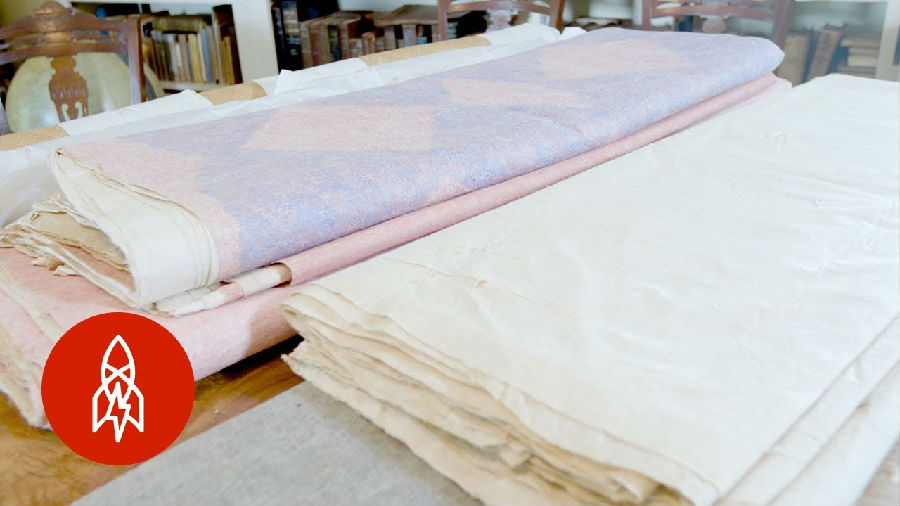The beauty of Kauai just fills my soul.
可爱岛的美已经装满了我整个心灵。
There are places of extreme beauty.
岛上有很多很多极其漂亮的地方。
And that for me is the Na Pali Coast where there is a hidden gem.
在我看来,最最漂亮的地方应该是纳帕利海岸,因为那里隐藏着一颗宝石。
An old village site called Niihau Kauai.
这颗宝石就是一个名叫尼豪可爱的古村遗址。
It is an absolutely ideal place to perpetuate Hawaiian culture.
那里绝对称得上是弘扬夏威夷文化的理想之地。
I teach Hawaiian studies here in Kauai, and the children call me Cuomo Kauka.
我在可爱岛教夏威夷研究,孩子们都叫我“科莫考卡”。
I teach Hula, which is Hawaiian dance, ōlelo Hawaii, which is Hawaiian language, and Kapa, which is Hawaiian barkcloth.
我教草裙舞,一种夏威夷舞,也教Olelo Hawaii,即夏威夷语,还教制作卡帕,这是夏威夷的一种树皮布。
Oh my God, it's so beautiful.
啊,天呐,这也太漂亮了。
In Hawaii, we did not have loomed material.
在夏威夷,我们是不用织布机织布的。
We made our clothing and our blankets from the bark of a tree.
我们的衣服和毯子都是用树皮制成的。
Kapa is made first by growing the plant and then harvesting it.
制作卡帕,首先要种这种树,然后把树砍回来。
Scraping off the outer bark.
刮掉外面的树皮。
Removing the inner bark and pounding it out.
把里面一层的树皮剥下来把浆打出来。
You got to pound, and pound, and pound and pound
要敲敲敲一直敲,
and then you need many, many strips and you fold them together and pound them all out as one.
然后把打实的布条叠放到一起敲打成一条。
But you've got to have the materials to teach Hawaiian arts.
问题是,教孩子们传承夏威夷艺术你总得有材料吧。
And those materials are very much based on plants.
那些材料大多都是从植物身上获取的。
You have to grow the Wauke in order to make Kapa.
比如,要制作卡帕这种布我们就得先种一种叫沃克的树。
That's why we have been return to Niihau Kauai for 27 year.
这就是为什么过去这27年,我们每年都要回尼豪可爱村遗址的原因。
There are no roads in there.
那边已经没有路了。
It is only accessible by boat or by air.
只能坐船过去或坐飞机过去。
You feel the sense of place when you land, when you walk along the little trail.
落地之后,走在这些小路上,你立马就会找到这个地方的那种感觉。

And when you look out at the ocean and you see the turtles that are resting on the beach.
眺望大海还能看到在海滩上休息的海龟们。
They have been on that beach for centuries.
他们在这儿已经住了好几百年了。
We've only been on that beach more recently.
那会儿我们人类都还没有来到这里。
Our first trip into Niihau Kauai was to return ancestral remains or Kpuna iwi,
我们第一次回尼豪可爱是回来还祖辈们的旧物的,
and, ever since that trip, we have been going back to take care this old village site.
从那以后,每次回来我们都会过来打理打理这个遗址。
And we have also planted Wauke there to make Kapa.
我们还在那边种了制作卡帕需要用到的沃克树。
And I am still trying to figure out my Kpuna, how my ancestors made as beautifully as they have.
直到现在,我都还没弄明白我们的祖辈们是怎么把卡帕做的那么漂亮的。
It's a process.
肯定有一个过程。
We have to relearn these things.
我们必须把这些(文化的)东西捡起来。
So it's a place of old Hawaii that brings much to our understanding of perhaps how life used to be.
所以,这里也算是老夏威夷能给我们带来很多有关过去生活的理解的一个地方。
Come in right here and you gotta cut it at the bottom.
过来这边,从根部砍。
I like to teach my children about Kapa
我喜欢教孩子们制作卡帕的知识,
because first of all they have to learn how to take care of the plants
因为首先他们必须学会照顾这些植物,
and then they have to learn how to harvest them and how to clean them and how to pound them.
然后才能学习如何收树皮,如何清理,如何敲打。
They know who they are.
他们知道自己是谁。
They know where they live.
知道自己住在哪里。
They know why they live here and what they can do to help.
也知道自己为什么住在这里,知道自己能做什么样的贡献。
How do Hawaiians see the land, that the land is the chief and that people are its servants.
夏威夷人如何看待这片土地,在我们眼里,土地才是酋长,人只是土地的仆人。











